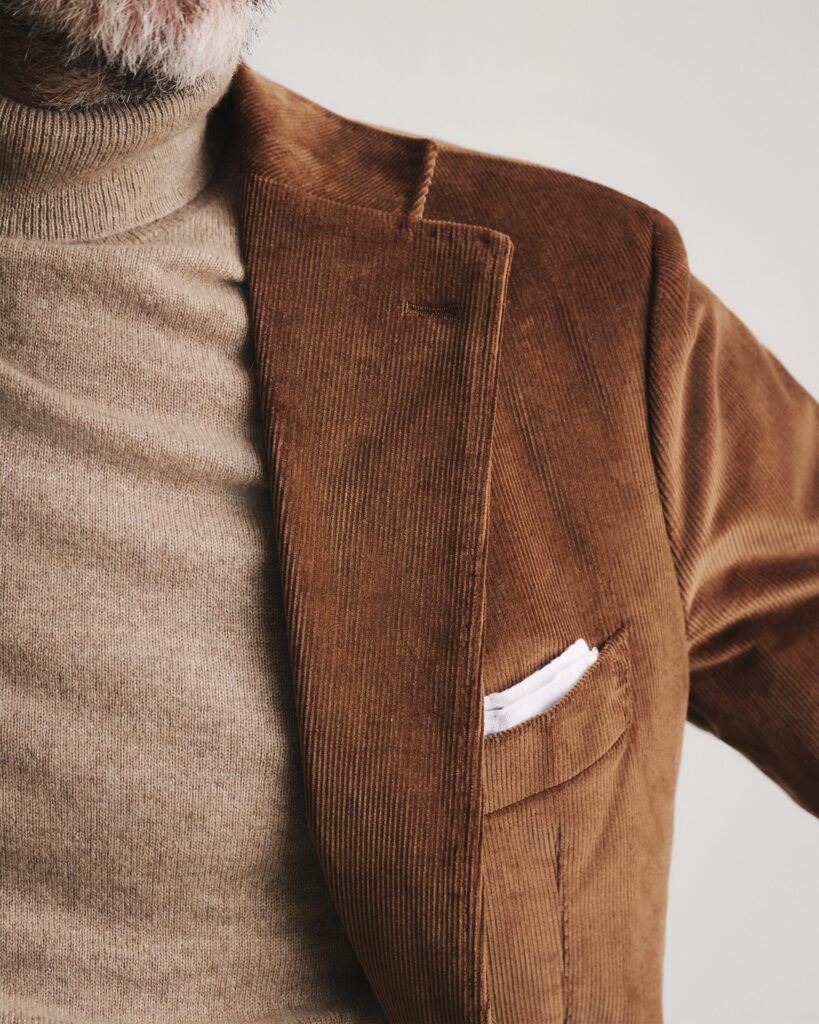If you like texture and layering, fall is the season to shine. Cooler weather provides an opportunity to break out some of the best materials in menswear. We’re examining the materials that comprise fall fashion and the process of combining them in a way that’s warm, practical, and stylish. This guide covers the best fabrics for fall and shows you how to layer them with confidence. So, here’s your men’s fall layering guide.
Fall Fabrics for Layering
Flannel
Flannel is a fall fabric that is brushed for softness. Traditionally, it was made of wool, but today you’ll often find it made of cotton. Because it was warm and durable, flannel was popular on the American frontier, giving it the strong, rugged association it has. Plaid flannels are popular top layers for fall, but don’t discount a timeless flannel suit.


Cashmere
If you want incredible softness and elegance, reach for cashmere. Made of the hair of a special breed of goat, cashmere is prized for its incredible hand feel. Cashmere is great for those autumn layers around the house and office, like sweaters, half-zips, and cardigans.


Corduroy
Corduroy is defined by its wales – the distinctive raised lines that appear as though the fabric is made of parallel cords. Corduroy often has a slight sheen and soft texture, appearing similar to velvet or velveteen. The fabric is warm and durable. It has a strong association with the fall, the holidays, and East Coast prep. You can’t go wrong with a pair of corduroy pants, but a corduroy sport coat or full suit is a great fall look.


Tweed
Usually made of wool, tweed is coarse and warm, keeping out the midst and chill of the British Isles. The garments have origins in traditional sporting in the United Kingdom, such as shooting and fishing. You’ll often see it in classic patterns like herringbone, houndstooth, or gun check. Tweed is dynamic, sharing associations with academic, preppy looks, outdoorsiness, and aristocratic style. Because of the warmth, you’ll often see it worn in fall and winter.


Part II: How to Layer for Fall
The Base Layer
Now that you know the fall fabrics, it’s time to talk about how to bring them together. Layering is an art of comfort and style. We recommend starting with a slim base layer in breathable fabric like lightweight cotton, linen, or merino wool that hugs without bulk and absorbs sweat near the skin. You can also think of this in terms of texture: think smooth → textured → rugged as you go outward.
The Mid-Layer
Over that baselayer, explore a mid-layer with texture, such as a flannel shirt, brushed twill overshirt, or a textured knit. These pieces add both warmth and visual depth, making your outfit feel seasonal without looking heavy.
The Hero Piece
This is also where you can incorporate one “hero” piece — a tweed blazer, corduroy overshirt, or patterned knit that anchors the look while letting your simpler layers play a supporting role.
The Gut Check
Make sure each layer stands on its own. If you remove the blazer or overshirt, the sweater and shirt underneath should still look deliberate.
Men’s Fall Layering Guide Shorthand
Like any other season or occasion, this is about personal expression and comfort, so take these fall layering tips as thought starters and not set rules.
- Consider limiting to about three visible layers so things don’t get bulky or too hot
- Treat colors and patterns with moderation to start; keep the base simple so the outer layers shine.
- Explore color tones that match the season
Easy Fall Outfit Guide
- Business Casual: OCBD + navy merino sweater + flannel trousers + brown tweed blazer
- Weekend: Brushed cotton flannel shirt + quilted vest + selvage denim + suede boots
- Evening Out: Black rollneck sweater + cashmere sport coat + wool trousers



For more inspiration, you can get in touch with customer service for some styled advice or consider visiting a showroom if you’re in the New York, Chicago, or Washington, D.C. areas.